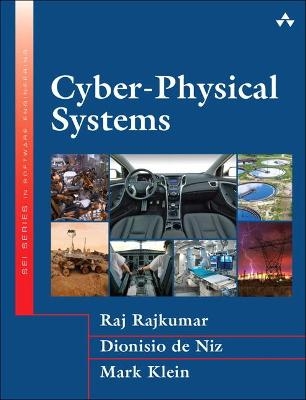
Cyber-Physical Systems
Addison-Wesley Educational Publishers Inc (Verlag)
978-0-321-92696-8 (ISBN)
The next generation of mission-critical and embedded systems will be “cyber physical”: They will demand the precisely synchronized and seamless integration of complex sets of computational algorithms and physical components. Cyber-Physical Systems is the definitive guide to building cyber-physical systems (CPS) for a wide spectrum of engineering and computing applications.
Three pioneering experts have brought together the field’s most significant work in one volume that will be indispensable for all practitioners, researchers, and advanced students. This guide addresses CPS from multiple perspectives, drawing on extensive contributions from leading researchers.
The authors and contributors review key CPS challenges and innovations in multiple application domains. Next, they describe the technical foundations underlying modern CPS solutions—both what we know and what we still need to learn. Throughout, the authors offer guiding principles for every facet of CPS development, from design and analysis to planning future innovations.
Comprehensive coverage includes
Understanding CPS drivers, challenges, foundations, and emerging directions
Building life-critical, context-aware, networked systems of medical devices
Creating energy grid systems that reduce costs and fully integrate renewable energy sources
Modeling complex interactions across cyber and physical domains
Synthesizing algorithms to enforce CPS control
Addressing space, time, energy, and reliability issues in CPS sensor networks
Applying advanced approaches to real-time scheduling
Securing CPS: preventing “man-in-the-middle” and other attacks
Ensuring logical correctness and simplifying verification
Enforcing synchronized communication between distributed agents
Using model-integration languages to define formal semantics for CPS models
Register your product at informit.com/register for convenient access to downloads, updates, and corrections as they become available.
Ragunathan (Raj) Rajkumar is the George Westinghouse Professor in Electrical and Computer Engineering at Carnegie Mellon University. Among other companies like TimeSys, he founded Ottomatika, Inc., which focused on software for self-driving vehicles and was acquired by Delphi. He has chaired several international conferences, has three patents, has authored a book and co-edited another, and has published more than 170 refereed papers in conferences and journals. He received a B.E. (Hons.) degree from the University of Madras, India, and M.S. and Ph.D. degrees from Carnegie Mellon University, Pittsburgh, Pennsylvania. His research interests include all aspects of cyber-physical systems. Dionisio de Niz is a Principal Researcher at the Software Engineering Institute at Carnegie Mellon University. He received an M.S. in information networking from the Information Networking Institute and a Ph.D. in electrical and computer engineering from Carnegie Mellon University. His research interests include cyber-physical systems, real-time systems, and model-based engineering. In the real-time arena he has recently focused on multicore processors and mixed-criticality scheduling, and has led a number of projects on both fundamental research and applied research for the private industry and government organizations. He worked on the reference implementation and a commercial version of the Real-Time Java Specification. Mark Klein is Senior Member of the Technical Staff at the Software Engineering Institute and is Technical Director of its Critical System Capabilities Directorate, which conducts research in cyber-physical systems and advanced mobile systems. His research has spanned various facets of software engineering, dependable real-time systems, and numerical methods. Klein’s most recent work focuses on design and analysis principles for systems at scale, including cyber-physical systems. He is co-author of many papers and three books: Ultra-Large-Scale Systems (Software Engineering Institute/Carnegie Mellon, 2006), Evaluating Software Architectures (Addison-Wesley, 2001), and A Practitioner’s Handbook for Real-Time Analysis (Springer, 1993).
Introduction xiii
Part I: Cyber-Physical System Application Domains 1
Chapter 1: Medical Cyber-Physical Systems 3
1.1 Introduction and Motivation 4
1.2 System Description and Operational Scenarios 5
1.3 Key Design Drivers and Quality Attributes 9
1.4 Practitioners’ Implications 48
1.5 Summary and Open Challenges 52
References 53
Chapter 2: Energy Cyber-Physical Systems 61
2.1 Introduction and Motivation 62
2.2 System Description and Operational Scenarios 63
2.3 Key Design Drivers and Quality Attributes 65
2.4 Cyber Paradigm for Sustainable SEES 79
2.5 Practitioners’ Implications 96
2.6 Summary and Open Challenges 97
References 100
Chapter 3: Cyber-Physical Systems Built on Wireless Sensor Networks 103
3.1 Introduction and Motivation 104
3.2 System Description and Operational Scenarios 105
3.3 Key Design Drivers and Quality Attributes 115
3.4 Practitioners’ Implications 122
3.5 Summary and Open Challenges 124
References 125
Part II: Foundations 131
Chapter 4: Symbolic Synthesis for Cyber-Physical Systems 133
4.1 Introduction and Motivation 134
4.2 Basic Techniques 135
4.3 Advanced Techniques 152
4.4 Summary and Open Challenges 158
References 159
Chapter 5: Software and Platform Issues in Feedback Control Systems 165
5.1 Introduction and Motivation 166
5.2 Basic Techniques 167
5.3 Advanced Techniques 171
5.4 Summary and Open Challenges 192
References 193
Chapter 6: Logical Correctness for Hybrid Systems 197
6.1 Introduction and Motivation 198
6.2 Basic Techniques 200
6.3 Advanced Techniques 221
6.4 Summary and Open Challenges 231
References 232
Chapter 7: Security of Cyber-Physical Systems 237
7.1 Introduction and Motivation 238
7.2 Basic Techniques 239
7.3 Advanced Techniques 248
7.4 Summary and Open Challenges 256
References 256
Chapter 8: Synchronization in Distributed Cyber-Physical Systems 259
8.1 Introduction and Motivation 259
8.2 Basic Techniques 262
8.3 Advanced Techniques 270
8.4 Summary and Open Challenges 282
References 283
Chapter 9: Real-Time Scheduling for Cyber-Physical Systems 289
9.1 Introduction and Motivation 290
9.2 Basic Techniques 291
9.3 Advanced Techniques 301
9.4 Summary and Open Challenges 325
References 325
Chapter 10: Model Integration in Cyber-Physical Systems 331
10.1 Introduction and Motivation 332
10.2 Basic Techniques 333
10.3 Advanced Techniques 338
10.4 Summary and Open Challenges 356
References 357
About the Authors 361
About the Contributing Authors 363
Index 371
| Erscheint lt. Verlag | 10.4.2017 |
|---|---|
| Reihe/Serie | SEI Series in Software Engineering |
| Verlagsort | New Jersey |
| Sprache | englisch |
| Maße | 185 x 240 mm |
| Gewicht | 840 g |
| Themenwelt | Mathematik / Informatik ► Informatik ► Betriebssysteme / Server |
| Informatik ► Weitere Themen ► Hardware | |
| Technik ► Elektrotechnik / Energietechnik | |
| ISBN-10 | 0-321-92696-X / 032192696X |
| ISBN-13 | 978-0-321-92696-8 / 9780321926968 |
| Zustand | Neuware |
| Informationen gemäß Produktsicherheitsverordnung (GPSR) | |
| Haben Sie eine Frage zum Produkt? |
aus dem Bereich


